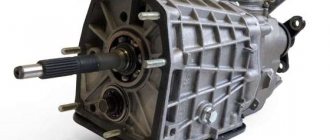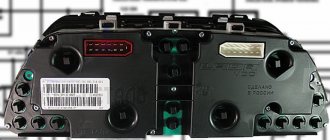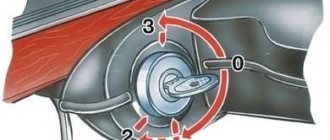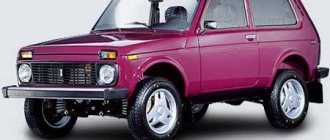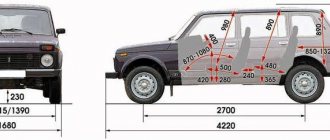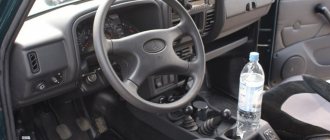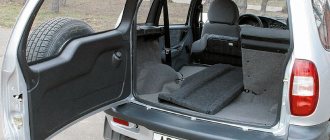The transmission is designed to transmit torque from the engine to the driving wheels of the car.
The car uses a mechanical transmission, which includes: clutch, gearbox, transfer case, cardan drives, final drives, differentials (inter-wheel and center-axle) and drive wheel drives.
A schematic diagram of the transmission of the Niva VAZ-2121 car is shown in Fig. 33. Torque from engine 1 is transmitted through clutch 2 to gearbox 3, where it changes in accordance with the gear engaged. From the gearbox, torque is transmitted through cardan gear 4 to transfer case 5, in which it is distributed equally between the front 14 and rear 8 drive axles of the vehicle by the center differential 6. From the transfer box, torque through cardan gears 7 and 13 is supplied to the main gears of 9 drive axles , in which it increases, and further through differentials 10 and drives 11, 16 to the rear 12 and front 15 drive wheels. In cross-axle differentials 10, the torque is distributed equally between the right and left wheels of each axle. The drive of the rear axle drive wheels includes
only axle shafts. The front axle wheel drive consists of two cardan drives, each of which has two universal joints. This makes it possible to supply torque to the front drive and steered wheels.
Rice. 33. Schematic diagram of a car transmission
The transmission is designed to transmit torque from the engine to the driving wheels of the car.
The car uses a mechanical transmission, which includes: clutch, gearbox, transfer case, cardan drives, final drives, differentials (inter-wheel and center-axle) and drive wheel drives.
In Fig. Figure 25 shows a schematic diagram of the transmission of the Niva VAZ-2121 car.
Diagram and description of the Niva 2121 transmission
The legendary Niva is an all-wheel drive vehicle. This ensures unprecedented road holding and reliability comparable to expensive high-performance cars. With the exception of updated versions under the Chevrolet brand, the traditional Niva has always had a rather modest design, but this did not prevent it from being the undisputed leader among car owners who prefer high-end car platforms.
What distinguishes the Niva's chassis from other all-wheel drive vehicles is the transmission of torque to two axles at once without disabling the axles, which significantly affects cross-country ability while simultaneously reducing the influence of critical loads on the transmission. This same quality makes this legendary Russian SUV very uneconomical in terms of fuel consumption.
The legendary Niva is an all-wheel drive vehicle. This ensures unprecedented road holding and reliability comparable to expensive high-performance cars. With the exception of updated versions under the Chevrolet brand, the traditional Niva has always had a rather modest design, but this did not prevent it from being the undisputed leader among car owners who prefer high-end car platforms.
What distinguishes the Niva's chassis from other all-wheel drive vehicles is the transmission of torque to two axles at once without disabling the axles, which significantly affects cross-country ability while simultaneously reducing the influence of critical loads on the transmission. This same quality makes this legendary Russian SUV very uneconomical in terms of fuel consumption.
Transmission VAZ 21213, VAZ 21310 (Niva)
Cars of the VAZ 2121, 21213, 21310 family and their modifications have permanent all-wheel drive. This means that while driving, torque is transmitted to any wheel of the car. In reality, it turns out that only one wheel is driving. This is the wheel that is easier to rotate at a given moment in time. Depending on the nature of the road, it becomes easier for one or the other wheel to rotate. Therefore, the driving wheel of the car changes depending on road conditions. The drive wheel can be either front or rear, right or left.
Tips for owners
To make driving your car comfortable, read some important points:
- The usual, standard arrangement of the front and rear handles is forward and backward, respectively. Movement in this mode can and should be carried out in areas characterized by even and smooth surfaces.
- Locking the differential by switching the front handle to the rear position is best on roads characterized by increased slipperiness. This measure will give Niva stability. It is worth understanding that after overcoming the problem area, the handle will need to be returned to its original position.
- As noted earlier, downshift should be activated before a potential obstacle, but not while the car is already stuck.
- It is worth understanding that activating the lock when the vehicle is stationary is sometimes impossible, even if the clutch is depressed. This may be caused by the clutch teeth hitting the gear teeth. In this case, you can try to activate the lock by starting to drive slowly and make a slight turn. If problems arise with disabling the lock, it is recommended to perform the same procedure with the clutch depressed and the steering wheel slightly rocked.
Design and principle of operation of the Niva 2121 transfer case
The transfer case mechanism includes more than 60 independent parts, which is confirmed by the presented drawing. Therefore, it is quite prudent to name the main elements and their purpose.
- Frame
- Differential housing
- Shafts
- Couplings
- Oil seals
- Satellites
- Gears
- Flanges
- Levers
And also interesting: Air intake for Niva 21214 - installation on the hood with your own hands Video | TuningKod
A pair of gears are tightly seated on the drive shaft, one of them (large) is intended for high gear, the second (small) is responsible for low gear. They have serrations with straight and oblique profiles. The first ones are in contact with the coupling, the second ones - with the intermediate shaft. The inclusion of one or another row causes the coupling to move along the hub in the horizontal direction, after which it is connected to the gear on the transfer case drive shaft.
The intermediate position turns off the gearbox (the gearbox is open), and the vehicle cannot be moved in this mode. The front helical gear on the intermediate shaft is used to control the differential. The locking is engaged, or the rigid coupling of the drive shafts of both axles, is carried out through a clutch. The design is typical for modifications 21213 and 21214, and the latter is additionally equipped with a speed sensor drive.
In the operating state (with the transfer case reduction gear connected), the gear ratio in the first stage changes from 4.4 to 7.83, the second - from 2.52 to 4.58, the third - from 1.63 to 2.9, in the fourth - from 1.2 to 2.14, fifth - from 0.98 to 1.75, which is expressed in an increase in traction on the wheels.
- Housing Differential housing Shafts Couplings Seals Pinions Gears Flanges Levers
- Housing Differential housing Shafts Couplings Seals Pinions Gears Flanges Levers
How does a Niva transmission work?
The VAZ 2121, in other words, “Niva”, entered mass production in the 70s of the last century. This car belongs to the class of off-road passenger cars. In the history of the domestic automobile industry, Niva became the first car whose design used all-wheel drive. Let's take a closer look at the transmission device. This should be done in order to understand why, given its almost 40-year history, the Niva transmission differs from many other similar vehicles equipped with all-wheel drive and the ability to shift in the classical way or using a viscous coupling.
The transmission in the Niva family (2121, 2131) is designed in such a way that all-wheel drive is supplied to 4 wheels. Also characteristic is the presence of a center differential. The transmission includes a gearbox, a transfer mechanism, a pair of cardan shafts, and both axles. A characteristic feature of the 2131 model is its elongated body. Otherwise, the main similarities with the first model can be traced throughout. Torque is transmitted from the engine through the gearbox to the transfer case, and it, in turn, transmits torque to the axles.
Then it goes through the cardan shafts to the gearboxes. The front gearbox transmits torque to the wheels through the differential and constant velocity joints. Likewise for the rear, also protruding, driving wheels. It is precisely because the torque is distributed to 4 wheels simultaneously that the drive is called full drive. The designation is as follows – 4WD. Another domestic car, designed on a similar principle to the Niva, is the UAZ.
The main purpose of the Niva 2121 transfer case
The transfer case (another name is the range multiplier) is connected directly to the gearbox, participates in the distribution of rotation on the axis of the all-terrain vehicle and helps to increase the torque when transmitted to the wheels of the vehicle.
Niva 2121 transfer case cross-sectional diagram
It is necessary to list the main reasons why the RK failed on a Chevrolet. The most common is frequent driving of a given vehicle at high speeds, which negatively affects the working life of the component parts of the box. In particular, the seals may wear out and the fastenings may become loose.
The transfer case is noisy. To solve this problem, you can buy special silent levers for the RK. Thanks to this, the necessary noise insulation is achieved and vibrations will not be noted.
Modified versions
The Niva's standard transmission, for all its advantages, often causes uncomfortable noise in the cabin.
This is generally related to the design, but using engineering developments, you can modernize it and make the car much quieter. This approach has already been applied in the VAZ-21213 model; as a result, even at a speed of 100 km/h you don’t feel any unpleasant noise, you can talk calmly and hear your interlocutor without effort. For these purposes, a number of modernization methods have been used: from unloading the floor near the transfer case and manual transmission mounts, reducing the load on shaft bearings to smoothing out peak torques under conditions of increasing loads on the transmission. The effect is achieved by changing the mounting location of the front axle gearbox, which in the modernized version is suspended at a distance from the engine on rubber supports. This approach makes it possible to reduce to a minimum the reactive torque in the longitudinal-vertical direction and the noise level at speed.
The noise in the modernized Niva transmission is comparable to that of a Zhiguli. It becomes more comfortable to be in the car when driving off-road. Upgrade costs are negligible; modification requires only the master's understanding of the design itself and a little time.
Transfer case control
The Niva 2121 transfer case has manual control with a lever-type mechanical drive. The shift lever swings in the longitudinal direction and is performed on an axis that is installed in the bracket eyes in front of the transfer case. Friction is reduced by pressed plastic bushings into the holes of the lever.
The lower part of the lever is inserted into a groove on the rod, and fixation occurs using a figured spring. The other end of the rod, in turn, is connected to a fork, which moves the shift clutch. The rigidity of this connection is ensured by the bolt. The rod at the outlet of the transfer case is sealed with an oil seal, and dirt and dust are protected with a rubber corrugation. The entire switching drive is fixed in the set position by a spring-loaded ball that fits into special grooves in the rod.
Possible problems
During the operation of off-road vehicles, parts and components of the transfer case gradually become unusable due to wear. Most often, the following interruptions in the operation of the mechanism occur:
- The front axle does not engage.
- The transfer case is overheating.
- Leaks and increased oil consumption of the transfer case.
- Unauthorized disabling of the front axle.
Harsh operation and insufficient attention to how to use the transfer case on the Niva 2121 lead to the appearance of:
- Vibrations in the body while moving Vibrations when starting Hum Noise when maneuvering Tight switching on modes
Also interesting: What kind of car are the wheels for the field from?
Experience shows that the culprits are: insufficient oil level, incorrect centering of the steering wheel, loosening of the support fastenings and damage to the rubber bands. An additional influence is exerted by the condition of the cardan and the engine itself.
- Vibrations in the body while driving
- Vibrations at start
- Gula
- Noise when maneuvering
- Tight switching modes
Useful tips
To use the lock installed on the Niva effectively, use the following recommendations from experts:
- When driving on good quality road surfaces, install the front transfer handle at the front and the rear at the rear.
- The front handle is moved back if the road becomes slippery. Once the slippery area has been passed, switch the levers to normal mode.
- If the Niva is stopped, the lock may not engage when the clutch is depressed. This occurs due to the alignment of the teeth with the gear teeth. What should you do in this case? Moving as if on a turn, engage the lock. The differential will turn and the gear teeth will come closer to the teeth. If turning off is difficult, do it while the vehicle is moving, maintaining a minimum speed and squeezing the clutch.
Forced unlock
Sometimes it happens that the lock gets stuck - it cannot be turned off even when the car is completely stopped. The situation is quite common for the Chevrolet Niva. How to solve it? There is a sure way. To do this, engage reverse gear, accelerate a little and turn off the differential lock while driving.
What to do in such a situation? It is necessary to turn on the first speed and try to turn off the unit again. Moving back and forth will solve the problem of a stuck differential. In general, it is recommended to turn on the center lock only in serious off-road conditions. At the intersection of dirt roads and sand dunes, a downshift is sufficient.
Turning on all-wheel drive.
The use of blocking will be justified in the following cases:
- If there is a possibility of wheel slipping, in areas with poor surface conditions,
- If there is a lack of engine thrust at high speeds,
- When driving on roads with loose surfaces, snow, ice.
You should also take into account some features of the Chevrolet Niva, namely, the helplessness of the transmission when hanging diagonally. In this mode, the wheels begin to spin, so if necessary, you need to dig under the wheel or make an embankment under the raised axle.
Disabling the front axle in the field
Is it necessary to modify the VAZ 4×4 Niva transfer case?
Cheviniva in 4x2 mode (disable all-wheel drive), leaving only.
If the lock does not turn on using the specified method, do not use excessive force. How to disable the immobilizer on a VAZ. Just repeat the entire sequence of actions from the beginning.
Switching to a lower gear is also allowed without stopping the Niva completely, but this can only be done by experienced drivers. The fact is that the transfer case, unlike the gearbox, does not have synchronizers installed. Changing from a lower gear to a higher gear while the car is moving is undesirable, although it is allowed in extreme cases.
It is not recommended to keep the center differential of the wheels in locked mode at all times, especially when driving on asphalt roads, as this will not only lead to increased fuel consumption by the vehicle and poor handling, but also to the breakdown of expensive transmission components.
It is preferable to enable forced blocking in various modifications of the Niva in the following situations:
- The blocking must be turned on in advance if you have to overcome a difficult route.
- On sharp climbs uphill or when driving downhill.
- While crossing terrain with a top layer of sand.
- When you have to drive on snow drifts or an icy road.
And also interesting: Niva transfer case: howl, vibration, hum » PERMANENTLY getting rid of extraneous sounds
Wheel locking is not necessary when driving quietly on a flat road within the city. Grip on asphalt surfaces will be decent, and traction will be distributed evenly by default.
How to use all-wheel drive and transfer case on a Niva
Since we have already found out that when they ask the question “how to turn on 4VD on a Niva,” they actually mean how to turn on the center differential lock, let’s look at the instructions for using the transfer case.
For off-road conditions, Niv transfer cases have two options and two mechanisms. The first is a differential lock. The second is the reduction/increasing gear shaft.
On normal asphalt roads, an overdrive shaft is always used and the differential lock is turned off. This is the “normal” mode of operation of the car, when it should drive like any city car. How to install the levers correctly - read below in the section about the control of different Niva models.
The following modes are used off-road. A reduction gear without differential locking is needed when the car needs more traction - in sand, in mud, when driving downhill, when starting with a heavy trailer.
Shifting to a lower range of gears can only be done with the car stationary before starting to move through a difficult section or when driving at a speed of up to 5 km/h, because the Niva gearbox does not have synchronizers! But you can switch to a higher gear while the car is moving, with the clutch disengaged.
Blocking is used in the following cases - if the area becomes particularly difficult to pass and when a wheel slips/hangs on one of the axles. You can lock the differential while the car is moving, but before entering a difficult section of the road. Most often this function is used in conjunction with downshift. With overdrive, the locked differential can be used when driving on relatively flat sections of the road without asphalt.
Many sources write that you need to engage the differential lock when driving on slippery snow and ice. But there are no such recommendations in the user manual - they suggest, if necessary, using this function only if you are unable to move on such a surface. And “Behind the Wheel” journalists, during tests of the Chevrolet Niva, determined that on a slippery surface, the blocking only helps when driving downhill. During acceleration, this mode increases the risk of slipping, and in turns it worsens handling!
It is not recommended to make any shifts directly when the wheels are slipping. You should also not drive with the differential locked at speeds above 40 km/h . Including because such driving worsens the car's handling , increases fuel consumption and tire wear. And constant movement in this mode will generally lead to breakdown of mechanisms and transmission parts. Therefore, in all Niva cars and Chevrolet Niva, the all-wheel drive icon on the instrument panel lights up when the differential is locked. Even if you forgot to unlock it, the warning light will prompt you to correct the situation.
In practice, it can be very difficult to engage the differential lock. This happens because the coupling teeth of the units rest against the teeth of the gear. You should not apply force in such a situation - you can simply break the lever or mechanism! Such “sticking” is not a sign of a breakdown, but normal operation of the transfer case. This is a purely mechanical unit that works this way.
According to the instructions, the Niva differential lock at speeds up to 5 km/h , while pressing/squeezing the clutch twice. But the practice of car owners shows that it will be more effective to do this not while driving in a straight line, but by making a non-sharp turn. When the wheels are turned, the locking lever is easily engaged. A similar problem may occur with turning off the lock. The method is the same, but moving backwards with a slight turn of the steering wheel will be more effective.
How to control the Niva transfer case levers in all modes (detailed video)
Niva differential lock control (short video)
Does Niva have one or two transfer case levers and how to control them?
Different Niv models have different implementations of the mechanism for controlling the functions of the transfer case .
The VAZ-2121, VAZ-2131 and LADA 4×4 models (three- and five-door) use two levers. Front - differential lock. In the “pressed forward” position, the differential is unlocked. In the “pressed back” position, the differential is locked. The rear lever is an up/down gear series. Rear position - increased number of gears. The middle position is “neutral” (in this position the car will not move, even with the gearbox engaged). Forward position - downshift.
The LADA Niva, VAZ-2123 and Chevrolet Niva models use one lever. In the standard position, the differential is unlocked, and the neutral and up/down positions are the same as described above. The differential is locked by pressing the handle towards the driver and this can be done while the gear is in low/high gear or in neutral.
Control diagram with two transfer levers
Transfer case control diagram with one lever
We help with all our wheels
How to enable all-wheel drive on a Chevrolet Niva? There is an option to block the center differential of the Chevy Niva both when the car is stationary and when it is not moving.
This is done with the clutch pedal depressed using the transfer case control lever, which is located behind the huge gear selector. When the lever is in the neutral position, you need to pull it towards the driver. If you later press in the opposite direction, a lower gear will engage with the center differential locked at a ratio other than 3.5.1. If you pull towards yourself, a lower gear is put into effect (gear ratio 1.5).
When the lever is in this position, the corresponding yellowish pictogram lights up on the dashboard. Disabling the front axle on a Chevrolet Niva. four-wheel drive. How to disable. If you cannot follow these instructions, try repeating the procedure while driving the vehicle.
The correct sequence for activating the lock while driving is given in the instruction manual for this vehicle. Niva permanent all-wheel drive - How it works and. It says here that such blocking should be done in advance, at the time the car is moving along a section of the road with a hard surface. How does all-wheel drive work on a Chevrolet Niva and Niva….
Features of the Nivov design
The features of the Nivov transmission include the presence of a center differential that connects the rear and front axles.
As a result, the wheels can rotate not only at different angles, but also at different angular speeds, which significantly affects controllability in impassable roads. The center differential is located in the transfer case and is similar in design to the cross-axle differential.
The key difference between the Niva’s center differential is the ability to lock when driveshafts rotate with the same characteristics. The center differential is manually locked only in difficult terrain conditions, when you need to overcome a large hole, rut or snow drift without slipping.
In practice, mechanical locking, although somewhat inconvenient, turns out to be better than the modern electromagnetic clutch used for these purposes. For example, the Renault Duster is not so easy to cope with the task in harsh off-road conditions, since the digital control unit can provide limited torque transmission. However, this effect will not be observed in a Niva with a mechanical lock.
Leaving the center differential locked will not only cause increased wear, but will also significantly reduce the vehicle's handling. The activated differential lock mode will be indicated by a lit indicator on the Niva dashboard. Please note that locking will not prevent one wheel from losing traction.
To overcome difficult areas, the transmission allows the use of a low gear with a high gear ratio (2.135); in the highest gear, the parameter is 1.2 and is intended for driving in normal conditions. The transfer case indicates different high and low gear modes. The lower one is turned on before entering a snowy area, unsteady soils, hills, and when a towed load is connected. The low gear compensates for the lack of power of the Niva’s “strong” engine and allows you to overcome difficult areas that only powerful cars can do.
Some drivers master the skill of shifting gears at speeds of 30-35 km/h. Otherwise, you will have to stop the car and perform the operation in the parking lot.
Please note that Niva requires a competent approach to the selection of tires, the quality of which can affect the degree of wear of the transmission in just one season. The tires must be the same in terms of wear and, of course, in size. Different characteristics will lead to increased load on the transmission and slipping in low gear, and during normal driving will increase wear on the differentials.
Rules for using differential
These include:
- Switching the transfer case should only be done when the car is not moving.
- You can also engage the differential while the vehicle is moving.
- You can switch to a lower gear while the car is moving.
- To ensure long-term and uninterrupted operation of the differential, it is necessary to periodically turn it on, especially in winter. This should be done once every 7 days.
To ensure that the locking mechanism lasts for a long time, use the following rules:
- It is necessary to switch the transfer case when the Niva does not move.
- The differential can also be engaged while the vehicle is moving.
- To ensure efficient and long-term operation of the device, it is advisable for the Niva driver to turn on the lock from time to time. Once a week in winter is enough.
Where is the lever responsible for switching located? Pay attention to the area between the wings located in front, there are 2 levers there. One makes it possible to change gears at the gearbox, the other successfully controls the transfer case.
The basis of the transfer case is a gearbox, which includes 2 stages. The control lever comes directly from it, you can move it forward and backward - this is how the gear is changed on the Niva. The direction of movement of the lever to the left and right allows you to activate the differential lock and vice versa to disable it.
Read news about the new Niva
- Characteristics of the NIVA 2121 engine - Shop of auto parts and accessories for Niva and NIVA-Chevrolet cars
- Do-it-yourself Niva 4x4 tuning: updating the interior of the Lada VAZ-2121
- Wheel sizes of iden Chevrolet Niva
- Low pressure tires - how to choose and buy?
- How to strengthen a GAZelle frame?
- Review of the standard alarm system Niva Chevrolet
- 41 reviews of Motor oil Gazpromneft (Gazpromneft) Super 5W-40 Semi-synthetic 4 l from OZON customers
- Is it possible to drive with a kanguryatnik on the field 2022 - Protection of rights
Differential
This mechanism is a kind of distributor of traction forces coming from the motor to the wheels. An important feature is that the latter have the ability to rotate at different speeds. The importance of having a differential mechanism is due to the fact that during turning maneuvers, the wheel located inside makes fewer revolutions when compared with the number of turns of the outer wheel.
